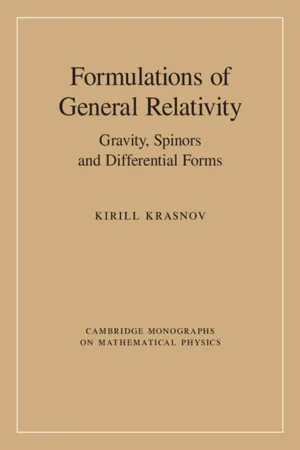
- English
- PDF
- Available on iOS & Android
About this book
This monograph describes the different formulations of Einstein's General Theory of Relativity. Unlike traditional treatments, Cartan's geometry of fibre bundles and differential forms is placed at the forefront, and a detailed review of the relevant differential geometry is presented. Particular emphasis is given to general relativity in 4D space-time, in which the concepts of chirality and self-duality begin to play a key role. Associated chiral formulations are catalogued, and shown to lead to many practical simplifications. The book develops the chiral gravitational perturbation theory, in which the spinor formalism plays a central role. The book also presents in detail the twistor description of gravity, as well as its generalisation based on geometry of 3-forms in seven dimensions. Giving valuable insight into the very nature of gravity, this book joins our highly prestigious Cambridge Monographs in Mathematical Physics series. It will interest graduate students and researchers in the fields of theoretical physics and differential geometry.
Frequently asked questions
- Essential is ideal for learners and professionals who enjoy exploring a wide range of subjects. Access the Essential Library with 800,000+ trusted titles and best-sellers across business, personal growth, and the humanities. Includes unlimited reading time and Standard Read Aloud voice.
- Complete: Perfect for advanced learners and researchers needing full, unrestricted access. Unlock 1.4M+ books across hundreds of subjects, including academic and specialized titles. The Complete Plan also includes advanced features like Premium Read Aloud and Research Assistant.
Please note we cannot support devices running on iOS 13 and Android 7 or earlier. Learn more about using the app.
Information
Table of contents
- Cover
- Half-title
- Series information
- Title page
- Copyright information
- Dedication
- Contents
- Preface
- Introduction
- 1 Aspects of Differential Geometry
- 2 Metric and Related Formulations
- 3 Cartan's Tetrad Formulation
- 4 General Relativity in 2+1 Dimensions
- 5 The `Chiral' Formulation of General Relativity
- 6 Chiral Pure Connection Formulation
- 7 Deformations of General Relativity
- 8 Perturbative Descriptions of Gravity
- 9 Higher-Dimensional Descriptions
- 10 Concluding Remarks
- References
- Index